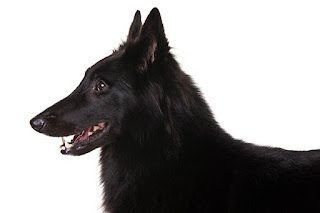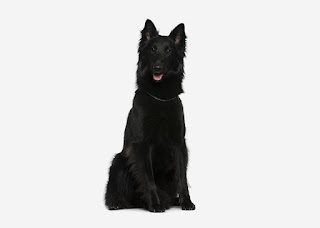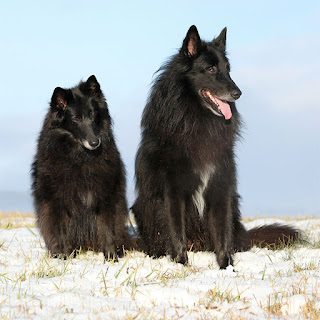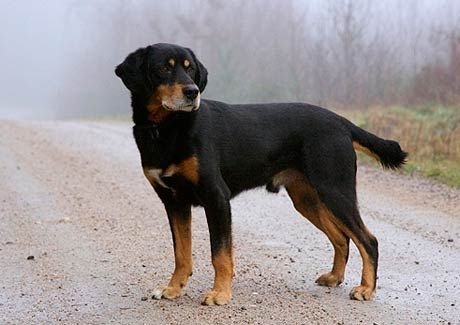Elegant, sporting a lovely basic black coat, the Belgian Sheepdog is not only graceful but versatile as well. Don’t let his good looks fool you. This dog is a workaholic in disguise. His work ethic is second to none and he is happiest when he has specific duties to perform. This breed is incredibly intelligent and can learn to do almost anything, with proper training. The Belgium Sheepdog isn’t all work and no play. He is an active fellow and will keep the kids busy playing fetch or Frisbee for hours.
Overview
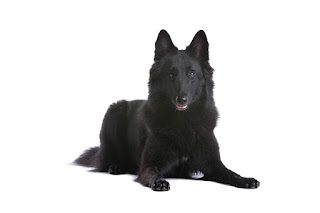
The Belgian Sheepdog, known as the Groenendael in Europe, is the solid-colored variety of the four Belgian shepherd dogs. Elegant and graceful, he has a long black coat and an imposing appearance. He’s athletic as well as beautiful and maintains the working ability for which he was originally known, making him an excellent choice for agility, herding, and obedience competitions.
His high energy levels necessitates much more activity than a simple walk around the block. Choose this breed only if you are a high-energy person who enjoys active daily exercises such as running, bicycling, and hiking. He’s also well suited any dog sport or activity you can teach, including agility, flyball, herding, obedience, rally, search and rescue, and tracking.
Loving and loyal, the Belgian Sheepdog will always protect “his” children, but it’s important for parents to supervise play when neighboring children are around. The Belgian may mistake the noise and high spirits of play as an assault and try to nip at your child’s friends. With proper supervision and corrections, you can teach him that this isn’t appropriate behavior. Belgian Sheepdogs do best with children when they’re raised with them from puppyhood or socialized to them at an early age.
Highlights
- The Belgian Sheepdog is also known as the Groenendael. He is the long-coated black variety of the four Belgian herding breeds. In Europe, the four Belgian Shepherd breeds are also known collectively as Chiens de Berger.
- Belgian Sheepdogs shed year-round and require 15 to 20 minutes of brushing weekly.
- Although they are good-size dogs, they are very people-oriented and want to be included in family activities.
- Shyness can be a problem in this breed. Choose the middle-of-the-road puppy, not the one beating up his littermates or the one hiding in the corner.
- Belgian Sheepdogs can get along well with other dogs and cats if they’re raised with them, but they have a chase instinct and will go after animals that run from them.
- Belgian Sheepdogs are play-oriented and sensitive. Keep training sessions fun, consistent, and positive.
- Belgian Sheepdogs require at least an hour of exercise per day. If you don’t provide them with exercise and mental stimulation in the form of training or play, they’ll find their own entertainment, and chances are it will be expensive to repair.
- Belgian Sheepdogs will chase joggers, bicyclists, and cars, so they need a securely fenced yard.
- Belgian Sheepdogs are very intelligent and alert. They also have strong herding and protection instincts. Early, consistent training is critical!
- When you look at a Belgian Sheepdog, you see an elegant dog with a square body, wedge-shaped head, triangular ears, dark brown eyes, and a long black coat with
Breed standards
AKC group: Herding
UKC group: Herding Dog Group
Average lifespan: 10–14 years
Average size: 60 to 75 pounds
Coat appearance: double-coated breed,long, straight hair that’s moderately harsh to the touch, never wiry or silky
Coloration: depends on variety,completely black or black with a bit of white between the pads of the feet
Hypoallergenic: No
Shedding Propensity: Seasonally heavy twice per year, with light shedding year-round
Best Suited For: Families with children, active singles, houses with yards, farms/rural areas
Temperament: Independent, watchful, protective, alert
The earliest documentation of the true Belgian Sheepdog dates back to the late 1800’s, when people in European countries were developing individual spirits of pride and nationalism that included developing dog breeds that would be identified with their particular homeland. The Club du Chien de Berger Belge was founded in 1891 for this very purpose, and it adopted the first Belgian Shepherd standard in 1893. The breed was registered by the Societe Royale Saint-Hubert in 1901. The long-haired Belgian Sheepdog was primarily developed and promoted by Nicolas Rose, a restaurateur and owner of the Chateau de Groenendael just south of Brussels. He established a thriving kennel dating back to 1893, and his stock became the basis of today’s beautiful black Belgian Sheepdogs, which were officially named the Groenendael in 1910.
While originally prized as superior herding dogs and as representatives of their home country of Belgium, this breed’s versatility and skills as a working dog became apparent even before World War I, when they were used as police and customs dogs in Europe and the United States. During the war, Belgian Sheepdogs were distinguished as message carriers and ambulance dogs. The fame of this breed took off after the war. The Belgian Sheepdog Club of America was founded in 1919, and by 1926 the breed was ranked 42nd out of 100 breeds recognized by the American Kennel Club. During the Great Depression, the Belgian Sheepdog’s popularity in the United States declined dramatically, and the American breed club ceased to function.
During World War II, the breed resurfaced as a military assistant and guard dog. The current Belgian Sheepdog Club of America was formed in 1949, and the breed standard was approved by the AKC in 1959. This breed continues to thrive in obedience, agility, conformation, tracking, schutzhund, herding, sledding, police work, search and rescue and as guide and therapy dogs. Perhaps their most profound accomplishment is being loving, gentle and devoted companions.
Belgian Shepherd Dogs are described as highly intelligent, alert, sensitive to everything going on around them and form very strong relationship bonds. They are said to be loyal, intelligent, fun, highly trainable and well suited to family life.They should receive plenty of socializing as puppies and will benefit from regular activity and close interaction with people throughout their lifespan. Their herding heritage gives them a comparatively high energy level, and mental as well as physical exercise is necessary to keep a Belgian happy and healthy. In 2012, the North Wales Police force harnessed a Belgian Shepherd herding behavior, headbutting, in a novel approach to subduing criminals. The dogs are muzzled to prevent bites, and trained to forcefully headbutt targets at the midriff on command, knocking them off balance.
Belgian Shepherds do well in sports such as obedience training and dog agility. They are used as assistance and search and rescue dogs, as well as police, military and narcotics dogs.
Health
Both elbow and hip dysplasia are prevalent in the breed. Other health issues such as epilepsy, cancer and progressive retinal atrophy have been diagnosed as well. Belgian Sheepdogs often have sensitivity to anesthesia so caution should be taken when considering any kind of sedation.
The Belgian Sheepdog loves to live inside the house with its human family, although it can adapt to outdoor living. It also performs best when given access to the yard. Apart from that, exercise on a regular basis is essential for the breed and should ideally combine long hours of play and jogging. The Belgian Sheepdog’s coat requires the occasional brushing to keep away dead hairs, even more so during times of shedding.
Living Conditions
The Belgian Shepherd/Groenendael will do okay in an apartment if it is sufficiently exercised. It is moderately active indoors and will do best with at least an average-sized yard. The Groenendael can sleep outdoors, although he prefers to be with his people.
Trainability
Though sometimes willful and stubborn, Belgians are highly trainable and thrive on advanced obedience, trick and agility training. They can read small movements and even changes in facial expression, and are famous for being so “in tune” with their trainers that they can literally stay one step ahead of the person giving commands. For this reason, Belgian Sheepdogs are often competitors in agility and herding competitions.
Though easily trainable, Belgians are not for the first-time dog owner. They are highly intelligent and manipulative, and can easily walk all over someone who does not know how to remain consistent with training. Positive reinforcement is the best method to train a Belgian Sheepdog, as discipline can lead to avoidance behavior and stubbornness.
This breed requires a lot of exercise and would not be suitable for a sedentary family. The Belgian Sheepdog loves to run and play and could do so for long periods of time. He’ll play fetch, ball and Frisbee with the kids or happily go jogging with one of the adults. As long as he is active, the Belgian Sheepdog will be happy.
Without proper exercise, this breed can and will become destructive. They will bark incessantly and tear apart your furniture or chew up your shoes. All of this unwanted behavior can be avoided by keeping the Belgian Sheepdog physically active.
Grooming
Belgian Sheepdogs require a lot of brushing to maintain their year-round shedding and to keep the coat free of tangles and mats. Weekly brushing can take anywhere from 15 to 30 minutes, but daily swipes with a brush or comb can make the weekly sessions easier. Twice a year they will blow their entire coat, which will require extra grooming time. A warm bath can help release the hair and cut down the seasonal shedding time. Regular bathing only needs to occur as needed, if the dog is dirty or begins to emit a doggy odor.
Weekly teeth and ear cleaning can help promote health and keep harmful bacteria to a minimum. Active Belgians will naturally wear down their toenails, but if the nails click on a hard floor, they should be trimmed.
Belgian Shepherds are known to become devoted to their families showing a lot of affection to everyone in a household which includes children. They love nothing more than being involved in things that go on in a home environment and this includes playing lots of interactive games with the kids. However, any interaction between dogs and children should always be supervised by an adult to make sure playtime does not get too rough, which is especially true if the kids have any of the friends over.
If a well-bred and nicely-socialised Belgian Shepherd grows up with other animals and pets including cats in the home, they generally get on well together. Some dogs may show aggression to other dogs which is why it’s so important for puppies to be well socialised from a young age which must include them meeting other dogs once they have been fully vaccinated. Care should always be taken when a BSD is around any smaller animals and pets they don’t already know just to be on the safe side.
Is this breed right for you?
The Belgian Sheepdog is a loyal, friendly and affectionate friend. It may have a strong working-dog background, but it craves companionship and family time above everything else. Highly protective of its family, property and territory, the Belgian Sheepdog is a passionate but restrained watchdog. An alert and watchful companion to children, it flourishes when given a steady dose of good-natured play and affection.
Did You Know?
If you are crafty — or know someone who is — you can save a Belgian Sheepdog’s hair, have it spun into yarn, and knit it into socks, sweaters, hats, or afghans.

